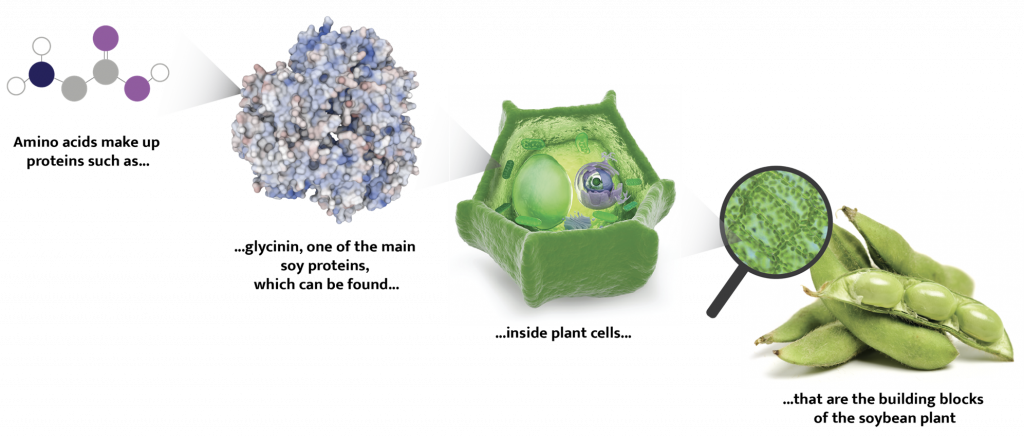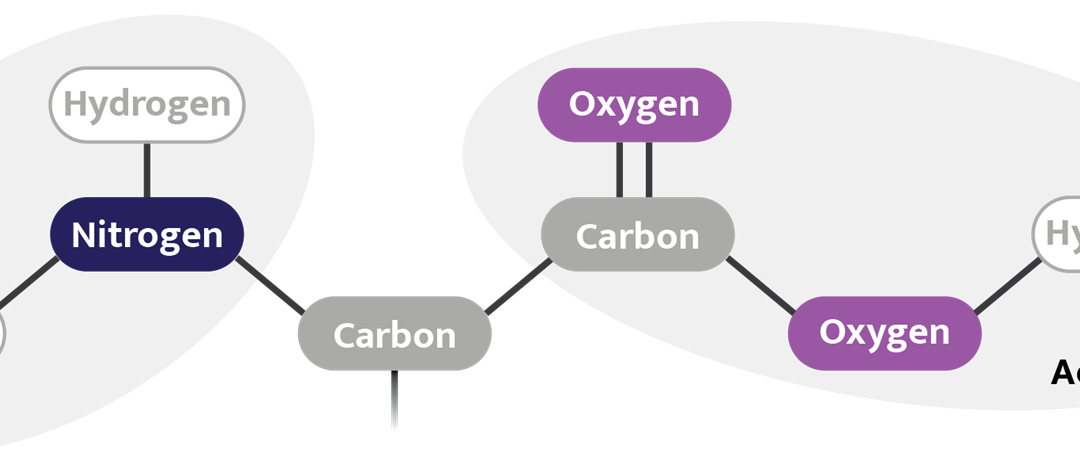You’ve been told protein is an essential part of your diet, but have you ever wondered why or what proteins are? And what about alternative proteins? Read on to understand what protein is, why it’s so important, and the ways that alternative protein technology is creating new, animal-free sources of dietary protein.
What is protein and why do we need it in our diet?
Protein is an essential part of our diets and should make up 10-35% of our daily calories.1 Yet, there is a subtle distinction between the term protein used in a dietary context and protein used in a biochemical context, when it describes the molecular workhorse of cells. The foods we categorize as “proteins” (like meat, dairy, nuts, and legumes) are full of the latter, though they contain more than just protein alone.1 What is it about protein that makes it so essential, what is it made of, and where is the protein in our food?
Proteins are all composed of the same biochemical building blocks called amino acids. Here, amino indicates the presence of an amine, which is nitrogen and hydrogen bonded together. Acid in this case refers to a substance that contains specifically arranged carbon, oxygen, and hydrogen. While some amino acids include other components, such as sulfur, these base elements—carbon, nitrogen, oxygen, and hydrogen—are familiar, essential parts of living organisms (carbon) and our atmosphere (nitrogen, oxygen, and hydrogen). Our bodies rely on these elements in the form of amino acids and proteins to power cellular processes.2

Long chains of amino acids fold into 3-D proteins – these can be long and fibrous, like the proteins in muscle, or spherical and gummy, like those that make up egg white.1 Proteins are found both inside and surrounding cells to make up living tissues from apples to our own organs. Proteins fulfill many biological roles from passively providing structure to actively turning on genes and breaking down waste.3 In our diets, proteins are broken down after being consumed in food to release valuable amino acids that are repurposed in the body.2

The most common proteins in animal-derived foods include collagen, actin, and myosin (the fibrous proteins which give steak its characteristic grain); ovalbumin (the most abundant protein in egg white); and casein (which gives cheese its bouncy chew).1 While these proteins strongly contribute to the flavor and texture profile of animal-based foods, they comprise just a percentage of the total weight. Meat is mostly water (~75%) and ~20% protein by mass while cow-derived milk is only ~4% protein by mass.6,7 Animal-based meat is also comprised of muscle cells (which contain muscle proteins), connective tissue cells, blood vessels, nerves, and fat cells.6 Animal-derived milk has protein along with carbohydrates, fat, minerals, and other nutrients.7 The complete profile of animal-based foods is an important consideration when making an “alternative protein” food product.
What are alternative proteins?
Alternative protein products provide an alternative source of nutrients, including proteins, to those from animal-derived foods. In some cases, as with plant-based foods, the proteins themselves are different (e.g., meat collagen versus soy glycinins).6,8 In other cases, companies produce bona fide animal proteins and/or tissue using a different means of production than the animals themselves. These include animal cells, plants, fungi, and insects.9–11 Because proteins are ultimately digested into the same amino acids, if a balanced blend of amino acids is provided, food can fulfill the same nutritional purpose regardless of origin.2,12 In addition to nutrition, proteins also dictate food texture, taste, and cooking behavior, which are all important considerations for alternative protein product development.1
What are sources of alternative proteins?
There are three categories of alternative protein technologies: plant-based, fermentation-derived, and cultivated.
Plant-based foods are the oldest alternative protein products—tofu was developed thousands of years ago—and represent a highly diverse group of foods.13 There are varieties of plant-based meat alternatives which range in their similarity to animal-based meat, from tofu and seitan to veggie burgers to the Impossible and Beyond Burgers. There are also a wide range of plant-based alternative dairy products, including milks, cheeses, and yogurts. Different plants are used to produce constituent ingredients for these foods, including soy, pea, corn, oat, and many others.1 Fungi (mushrooms) and algae, though not classified as plants, are also used to make alternative protein products using similar technology.13

Fermentation is another technology that can be used to produce alternative protein products, both in the form of whole foods and ingredients. Fermentation is a process by which living organisms, often bacteria or yeast, produce energy by chemically converting one substance into another. For centuries, societies have used the fermentation process of microbes to convert base ingredients into easily digested, nutritious, and preserved foods and beverages. This process is commonly associated with making beer or wine, but not all fermentation produces alcohol or takes place in a liquid. Cheese, yogurt, sourdough bread, and kimchi are all produced using fermentation.16 For alternative protein products, fermentation can be used in two ways. One way is to transform plant-based ingredients into whole food products, such as with soybean-derived tempeh.17 Another way is to produce high-value ingredients such as fats, dyes, and proteins, like the iron-containing hemoglobin-analog protein used to impart a meaty flavor and color to Impossible Burgers.17,18

Cultivated, cell-cultured, or cultured technology is the third pillar of alternative protein production. Cultivated meat is compositionally identical to animal-derived meat but does not require animal slaughter for production. To create these products, a small biopsy of cells is taken from an animal and used to grow a larger quantity of these cells—a culture—in nutrient-rich liquid media in growth tanks. The biopsied cells are typically stem cells which can be directed to become other cell types such as muscle or fat. After enough cells have grown, the culture can be harvested and formulated into a cultivated meat product, along with flavorings or other ingredients.20 The historic first commercial sale of a cultivated meat product, chicken nuggets, took place in Singapore in December 2020.21

What does the future hold for alternative proteins?
In 2021 alone, US $2.7 billion has been invested in alternative proteins through Q3 and this figure will rise to include several Q4 investments.23–27 Given the rapid expansion of these three technology pillars, it is predicted that alternative proteins will represent up to 22% of the total protein market by 2035.28 A future where non-animal derived foods are the default, rather than alternative, is rapidly approaching thanks to the ever-evolving approaches used to make these innovative products.
All icons sourced from The Noun Project. Corn, soy: KMG Design; lentil: Icons Producer; wheat: Tomas Knopp; potato, pea: Romaldon; chickpea: Zohaib Bajwa; milk: Misbahul Munir; sugar, RROOK; bacterium, Ben Davis; yogurt, iconxiar; cow, Rutmer Zijlstra; cell culture dish, Koson Rattanaphan; bioreactor, Mark Caron; burger; AB Designs.
References
1. McClements, D. J. & Grossmann, L. The science of plant-based foods: Constructing next-generation meat, fish, milk, and egg analogs. Comprehensive Reviews in Food Science and Food Safety vol. 20 4049–4100 (2021).
2. Wu, G. Dietary Protein Intake and Human Health. Food and Function vol. 7 1251–1265 (2016).
3. Alberts, B., Johnson, A. & Lewis, J. The Shape and Structure of Proteins. in Molecular Biology of the Cell (2002).
4. Itoh, T., Adachi, M., Masuda, T., Mikami, B. & Utsumi, S. Crystal Structure of Recombinant Soybean Proglycinin A3B4 subunit, its Comparison with Mature Glycinin A3B4 subunit, Responsible for Hexamer Assembly. RCSB PDB (2005) doi:10.2210/pdb2D5H/pdb.
5. Kristian Peters. Rhizomnium punctatum lamina. Wikimedia Commons https://commons.wikimedia.org/wiki/File:Rhizomnium_punctatum_lamina.jpeg.
6. Barrón-Hoyos, J. M. et al. Protein Quality Evaluation of Animal Food Proteins by In Vitro Methodologies. Food and Nutrition Sciences 04, 376–384 (2013).
7. Roy, D., Ye, A., Moughan, P. J. & Singh, H. Composition, Structure, and Digestive Dynamics of Milk From Different Species—A Review. Frontiers in Nutrition vol. 7 (2020).
8. Singh, A., Meena, M., Kumar, D., Dubey, A. K. & Hassan, M. I. Structural and Functional Analysis of Various Globulin Proteins from Soy Seed. Critical Reviews in Food Science and Nutrition 55, 1491–1502 (2015).
9. Post, M. J. et al. Scientific, Sustainability and Regulatory Challenges of Cultured Meat. Nature Food vol. 1 403–415 (2020).
10. Rubio, N. R., Fish, K. D., Trimmer, B. A. & Kaplan, D. L. Possibilities for Engineered Insect Tissue as a Food Source. Frontiers in Sustainable Food Systems vol. 3 (2019).
11. Rischer, H., Szilvay, G. R. & Oksman-Caldentey, K. M. Cellular Agriculture — Industrial Biotechnology for Food and Materials. Current Opinion in Biotechnology vol. 61 128–134 (2020).
12. Hoffman, J. R. & Falvo, M. J. Protein – Which is Best? ©Journal of Sports Science and Medicine vol. 3 http://www.jssm.org (2004).
13. Rubio, N. R., Xiang, N. & Kaplan, D. L. Plant-based and Cell-based Approaches to Meat Production. Nature Communications vol. 11 (2020).
14. Day, L. Proteins from land plants – Potential resources for human nutrition and food security. Trends in Food Science and Technology vol. 32 25–42 (2013).
15. Jarpa-Parra, M. Lentil protein: a review of functional properties and food application. An overview of lentil protein functionality. International Journal of Food Science and Technology vol. 53 892–903 (2018).
16. Tamang, J. P. et al. Fermented Foods in a Global Age: East Meets West. Comprehensive Reviews in Food Science and Food Safety 19, 184–217 (2020).
17. Kårlund, A. et al. Harnessing Microbes for Sustainable Development: Food Fermentation as a Tool for Improving the Nutritional Quality of Alternative Protein Sources. Nutrients 12, (2020).
18. Ismail, I., Hwang, Y. H. & Joo, S. T. Meat analog as future food: A review. Journal of Animal Science and Technology vol. 62 111–120 (2020).
19. Shiby, V. K. & Mishra, H. N. Fermented Milks and Milk Products as Functional Foods-A Review. Critical Reviews in Food Science and Nutrition vol. 53 482–496 (2013).
20. Reiss, J., Robertson, S. & Suzuki, M. Cell sources for cultivated meat: Applications and considerations throughout the production workflow. International Journal of Molecular Sciences vol. 22 (2021).
21. Sally Ho. Eat Just Makes First-Ever Commercial Sale Of Cultured Meat In Singapore. Green Queen HQ https://www.greenqueen.com.hk/eat-just-makes-first-ever-commercial-sale-of-cultured-meat-in-singapore/ (2020).
22. What is Cell Ag? New Harvest https://new-harvest.org/what-is-cellular-agriculture/#cellular-products.
23. JBS takes on cultivated meat market with acquisition. Food Engineering Magazine (2021).
24. Christine Hall. The EVERY Co. grabs $175M as it cracks code on animal-free protein products. Tech Crunch https://techcrunch.com/2021/12/07/the-every-co-grabs-175m-as-it-cracks-code-on-animal-free-protein-products/ (2021).
25. Jemima Webber. Impossible Foods Raises $2 Billion, Becomes Fastest Growing Plant-Based Meat Company. Plant Based News https://plantbasednews.org/news/economics/impossible-foods-plant-based-meat-billion/ (2021).
26. Jemima Webber. Alternative Protein Could Take Up 64% Of Global Protein Market By 2060, Report Finds. Plant Based News https://plantbasednews.org/news/economics/private-investments-alternative-protein/ (2021).
27. Martine Paris. Future Meat Raises $347 Million to Make Cell-Grown Meat in U.S. Bloomberg News https://ampvideo.bnnbloomberg.ca/future-meat-raises-347-million-to-make-cell-grown-meat-in-u-s-1.1697663 (2021).
28. Ben Morach et al. Food for Thought: The Protein Transformation. Boston Consulting Group Publications (2021).

About our guest blogger, Simone Costa, PhD:
I’m a biomolecular engineer with a passion for proteins. I thrive on building scientific strategy, creatively communicating science, and developing R&D solutions to deliver results. I have over ten years of experience in biotech with a sharp focus on protein engineering and biomaterials science.
After earning my PhD in protein engineering from Duke, I managed technical product development of engineered enzymes at a start-up making clean CPG ingredients. I continue to work on the cutting edge of science by providing strategic insight for pharma and biotech clients at Healthcare Consultancy Group while developing creative, impactful, and rigorously researched scientific content.
When I’m not dreaming about the unlimited potential for proteins to transform biotech and our food systems, I’m finding new plant-based recipes to try, taking long walks in NYC with my dog, or reading a good book.
Connect on LinkedIn.


Recent Comments